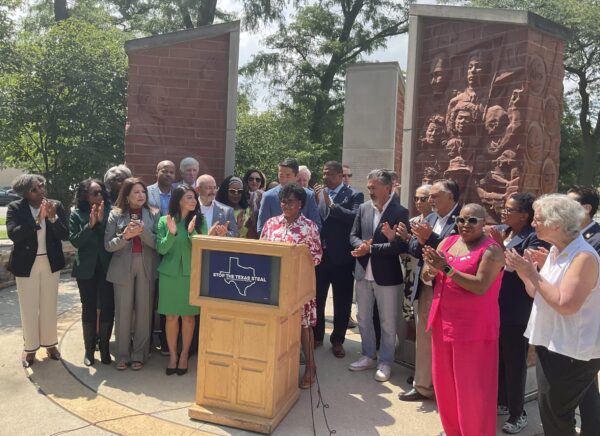
By Marilyn Odendahl
The Indiana Citizen
August 14, 2025
To explain why Indiana, a deep red state, is seriously considering redrawing its congressional districts this year in the hopes of sending, at most, two more Hoosier Republicans to Capitol Hill in 2026, attorney Jay Yeager pointed to the U.S. Supreme Court’s 2019 ruling in Common Cause v. Rucho.
The case presented the issue of configuring congressional districts to intentionally favor one political party over another. Common Cause, the plaintiff, argued such partisan gerrymandering violated the Constitution and two federal district courts agreed, striking down the challenged maps. However, a narrow 5-4 majority at the Supreme Court, led by Chief Justice John Roberts, found the federal judiciary did not have the authority to rule in disputes involving partisan redistricting.
“That decision, I mean, it is coming home to roost,” Yeager said. “Had that case gone one vote the other way, we would have had a different world. … Had those (district court) decisions been affirmed and had the rule been that you can’t engage in a partisan gerrymander, none of this would be happening.”
Yeager was part of a partisan gerrymandering brawl that broke out less than 10 years ago. Then a partner at what is now Faegre Drinker Biddle & Reath in Indianapolis, his former colleagues, including Harmony Mappes, fought against political redistricting in two consequential cases by helping draft a response brief in Gill v. Whitford from Wisconsin and helping represent the plaintiffs in the League of Women Voters of Michigan et al., v. Ruth Johnson.
The defendants’ victories in those partisan gerrymandering battles cleared the pathway for the current push by the Trump administration for an extremely rare mid-decade redistricting. Fearing the GOP will lose control of the U.S. House, President Donald Trump is pressuring red states to redraw their congressional districts to create more safe Republican seats.
Indiana got thrown into what Yeager has called the “Republican gerrymandering festival,” when Vice President J.D. Vance visited with Gov. Mike Braun and legislative leaders at the Statehouse last week. Since the meeting, the governor and House Speaker Todd Huston, R- Fishers, and Senate President Pro Tem Rod Bray, R-Martinsville, have been noncommittal about redrawing Indiana’s congressional maps. Lt. Gov. Micah Beckwith has been very vocal about his support for redistricting while some Republican lawmakers are openly expressing their opposition to the idea.

If even one more justice had joined the dissent in Rucho, opponents of gerrymandering would have had the power of legal precedent to fend off any attempts to draw partisan congressional and legislative maps, Yeager said. Governors and state lawmakers across the country would have known if they attempted to draw districts to the advantage of their political party, they would be sued and they would likely lose in court.
While litigation is still an option, the doors of the courthouse do not open as wide. Filing a complaint in federal court would pretty much be a nonstarter. In his opinion, Roberts specifically highlighted state courts as the venue for resolving political gerrymandering disputes, but as Yeager noted, litigation of this kind would still be very expensive and finding an attorney to take such a case might be difficult given how the Trump administration has targeted lawyers and law firms that have worked against the president’s interests.
Even Common Cause, which brought the lawsuit against Robert Rucho, the chair of the North Carolina Senate redistricting committee, is now changing its strategy for responding to the tit-for-tat mid-decade redistricting that is happening. The national voting rights advocacy group is now advancing a list of fairness criteria for states to follow if they choose to redistrict before the 2030 census.
Speaking at a virtual press conference Wednesday, Martha Tierney, chair of the national governing board of Common Cause, highlighted the reason the organization decided to take a different approach.
“We took, as I indicated, Common Cause v. Rucho to the Supreme Court and they refused to curb partisan gerrymandering,” Tierney said. “We helped craft the Freedom to Vote Act to ban partisan gerrymandering, but Congress did not pass. We have championed independent redistricting commissions nationally, yet neither party has embraced them fully. We are here in this moment because the courts, Congress, political leaders have failed to act, and our country is sliding toward authoritarianism.”
For Common Cause, filing a lawsuit remains one of several tools it could use to challenge partisan gerrymandering. Omar Noureldin, vice president of policy and litigation, said the organization would determine the “magnitude of the harm” created by any potential redrawn map and then evaluate the best response, whether through directly engaging the legislature, pursuing a ballot initiative or turning to the courts.
Common Cause will use its fairness criteria to review each redrawn congressional district and will push back on the maps that do not meet the six principles. However, the voting-advocacy group said it will not outright condemn all mid-cycle redistricting, because action is necessary to counter the Trump administration’s “authoritarian efforts to undermine representation and people-powered democracy.”
Under the six criteria, any mid-decade map must be proportional, racially equitable, and effective only until the 2030 census. Also, leaders pursuing mid-cycle redistricting must endorse the John R. Lewis Voting Rights Advancement Act and the Freedom to Vote Act, and they must endorse “a neutral, fair redistricting system” that could include citizen-led independent redistricting commissions.
Virginia Kase Solomón, president and CEO of Common Cause, emphasized the nonprofit is not acquiescing to Trump and state lawmakers who move forward with redistricting this year. The organization’s leaders are “being realists in this moment” by recognizing Republicans and Democrats in some statehouses are going to redraw their congressional maps mid-cycle. So the focus, she said, will be on advocating for the “everyday people” who do not always have a voice in state legislatures but will be impacted by any redistricting.
“We will look at each state’s proposal to see if (the redrawn maps) meet the criteria,” Kase Solomón said. “And if they do not, we will oppose them.”
Already Indiana’s maps are drawn to favor Republicans with seven of the state’s nine congressional seats held by the GOP. Christopher Warshaw, political science professor at Georgetown University, did an analysis of Indiana’s congressional districts, which the legislature adopted in 2021, and found even more partisan bias than there had been previously. In particular, he noted the new map changed the 5th Congressional District from a competitive seat that leaned Republican to a solidly Republican seat.
Still, litigating any district map would likely present the Indiana Supreme Court with a case of first impression. The state’s highest court does not appear to have ever addressed statewide gerrymandering, but it did adjudicate an Indianapolis redistricting dispute in 2003 in Peterson v. Borst. In that case, the Supreme Court overturned the Marion County Superior Court’s adoption of the maps created by the City-County Council’s Republican majority, finding that accepting a plan uniformly supported by one political party and uniformly opposed by the other is “incompatible with applicable principles of … judicial independence and neutrality.”

Civil rights attorney William Groth and Fred Biesecker, former general counsel for the late Gov. Frank O’Bannon, see the state’s constitution as providing legal grounds to oppose a mid-decade redistricting. Article 4, Section 5 of the Indiana Constitution requires the Indiana General Assembly to redraw the legislative districts after the decennial census, but is silent about reconfiguring congressional districts. Even so, the attorneys said an argument challenging an attempt to redistrict mid-cycle could be made under Article 1, Section 1, which, in part, guarantees Hoosiers “an indefeasible right to alter and reform their government.”
Aside from the legal arguments, Yeager said redrawing the congressional maps mid-decade would have lasting consequences by breaking the norm of redistricting every 10 years.
“What’s to keep states from just deciding they’re going to do it every two years,” Yeager said. “Now, I suppose you could do that, but it’s very disruptive and it doesn’t help good governance where voters get to actually choose their own representatives, rather than the other way around.”
Texas was the first to oblige Trump’s push to redistrict. The Republican majority recently redrew the state’s congressional map to make five more red districts, but Democrats have stalled the process by fleeing the state and preventing a vote on the new maps. California has since threatened to counterbalance the controversial maneuver in Texas by redistricting to create more blue seats.
Wednesday, Indiana Democratic lawmakers showed their solidarity with their Texas counterparts by traveling to Chicago where the Lone Star State legislators have been staying for two weeks. At a joint news conference, the elected officials denounced the attempts to redistrict mid-cycle just to retain power.

“In Indiana, state legislature members are elected by the people in the communities where we live,” Rep. Earl Harris, chair of the Indiana Black Legislative Caucus and Democrat from East Chicago, said. “Calling us back for a special session not aimed at helping our constituents, but to benefit someone in Washington, D.C., is a disservice to the voters.”
Gerrymandering had been refueled in 2010 by the Redistricting Majority Project, or REDMAP, which was implemented by the Republican State Leadership Committee. The effort was successful at helping Republicans gain control of several state legislatures and, by extension, put the GOP in charge of redrawing the congressional maps every 10 years.
Democrats had gotten more aggressive in response, so by about 2020, Yeager said, “there really was some progress made” in redistricting. Across the country, some citizen redistricting commissions had been established, decisions issued from other state courts had reigned in gerrymandering, and the partisan redistricting in the red and blue states had counterbalanced each other, so the gross disparity had been mitigated, he said.
Now the acrimony is rising and Yeager believes the headway made in recent years could be rolled back. That would only exasperate the bigger problem of gerrymandering, he said, which is political extremism. Ongoing gerrymandering has left just a fraction of the 435 seats in Congress actually competitive where the candidates face challengers in November elections.
“So what you end up with are much more extreme politicians, because only the primaries matter on either side,” Yeager said. “The politicians can run to the left and to the right, respectively, in the primaries and you end up with this polarity.”
Dwight Adams, an editor and writer based in Indianapolis, edited this article. He is a former content editor, copy editor and digital producer at The Indianapolis Star and IndyStar.com, and worked as a planner for other newspapers, including the Louisville Courier Journal.
The Indiana Citizen is a nonpartisan, nonprofit platform dedicated to increasing the number of informed and engaged Hoosier citizens. We are operated by the Indiana Citizen Education Foundation, Inc., a 501(c)(3) public charity. For questions about the story, contact Marilyn Odendahl at marilyn.odendahl@indianacitizen.org.